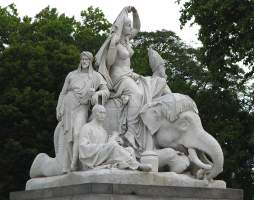
The Elephant does not appear in Victorian sculpture particularly frequently. The Albert Memorial has a full-size elephant, albeit on the small side, as part of H. J. Foley's Asia group. The large figures seated around it, and the one on top of it, rather obscure the animal, but the picture above shows both front and back of the great beast so we get something of the outline. As with a real elephant, supporting the mass of the body is a problem, even more so in stone than in the flesh, so that the sculptor has his elephant reclining. The tusks are cut and capped, the forehead is draped in a cloth, and the ears are small, for this is of course an Indian elephant.
Apart from very small heraldic elephants, I cannot think of another free standing elephant sculpture in any of the English towns I have visited, but we do have one rather large and solid elephant's head, high up on the front of Africa House, on Kingsway, London. This is a trophy head, posed with the trunk coiled, and the athletic African man next to it has the tusks across his shoulders. It is surprisingly unusual to have an elephant emblematic of Africa, though the importation of ivory from the continent is recognised, for example, on the Africa panel on Manchester's Free Trade Hall. John Thomas was the sculptor.
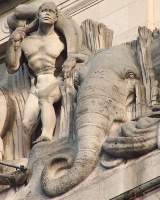
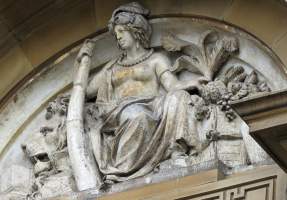 Africa House elephant, Kingsway; and girl with tusk on Manchester Free Trade Hall.
Africa House elephant, Kingsway; and girl with tusk on Manchester Free Trade Hall.
Panels in relief showing elephants include representations of Asia, the example springing to mind being the group on the front of the Foreign Office, Whitehall, by the sculptor H. H. Armstead. We see the elephant's huge head, trunk and ears, with the forward tusk prominent, again reminding us of the ivory trade which the Victorian viewer would have been particularly conscious of. A rather sad looking beast.
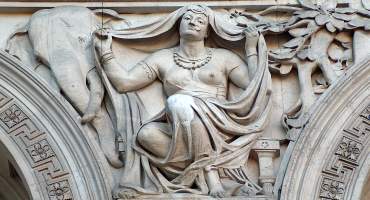 The Foreign and Commonwealth Office Asia group.
The Foreign and Commonwealth Office Asia group.
Here is another group in relief, on the building housing the Japanese embassy, in Piccadilly, again based on an elephant and a comely and exotic semi-clad girl. But here the elephant is as exotic as the female figure, with a headdress with pendant bobs, and an intelligent look in the eye.
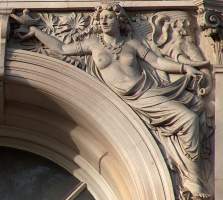 Exotic elephant, Japanese embassy, Piccadilly.
Exotic elephant, Japanese embassy, Piccadilly.
The elephant may be used as symbol of India rather than Asia as a whole, though many Victorians would not have particularly distinguished between the two, with China and Japan having different and separate allegorical sculpture. Here, then are two reliefs of elephants emblematic of India, one with a castle on the back, the other with a howdah - this latter being Edwardian, one of the colourful sculpted emblems on India House in Aldwych (thus very close to Africa House noted above). The India House example is rather stylised, aiming for decorative effect; the one with a castle, which is heraldic, nevertheless has a naturalistic pose to the feet and snakelike wave to the trunk. (Another very small Indian elephant in high relief, a modern piece, is shown on this page.)
Here is an example of a rather idiosyncratic elephant, from earlier than Victorian times, a rather Duresque creature created by a sculptor who likely would have only seen engravings of the animal, and we see a rather segmented trunk, a great acanthus-like ear, and something of a mane and whiskers - a spirited beast indeed.
Finally, though rather outside the scope of these pages, it would be churlish not to give a nod to the various temporary modern elephant sculptures, if sculptures they can be called, that appear in London and elsewhere. A couple of years ago, there were many dozens of painted plastic elephants scattered across London over the summer, a few of which may still be seen in the entrances of various hotels and so forth. But our picture here dates from a little earlier and shows one of the group of splendid basket-woven elephants which were erected for a regrettably short period in Hyde Park.
Visits to this page from 13 Mar 2014: 3,565 since 20 September 2022
Lion sculpture // Other animal sculpture // Allegorical sculpture